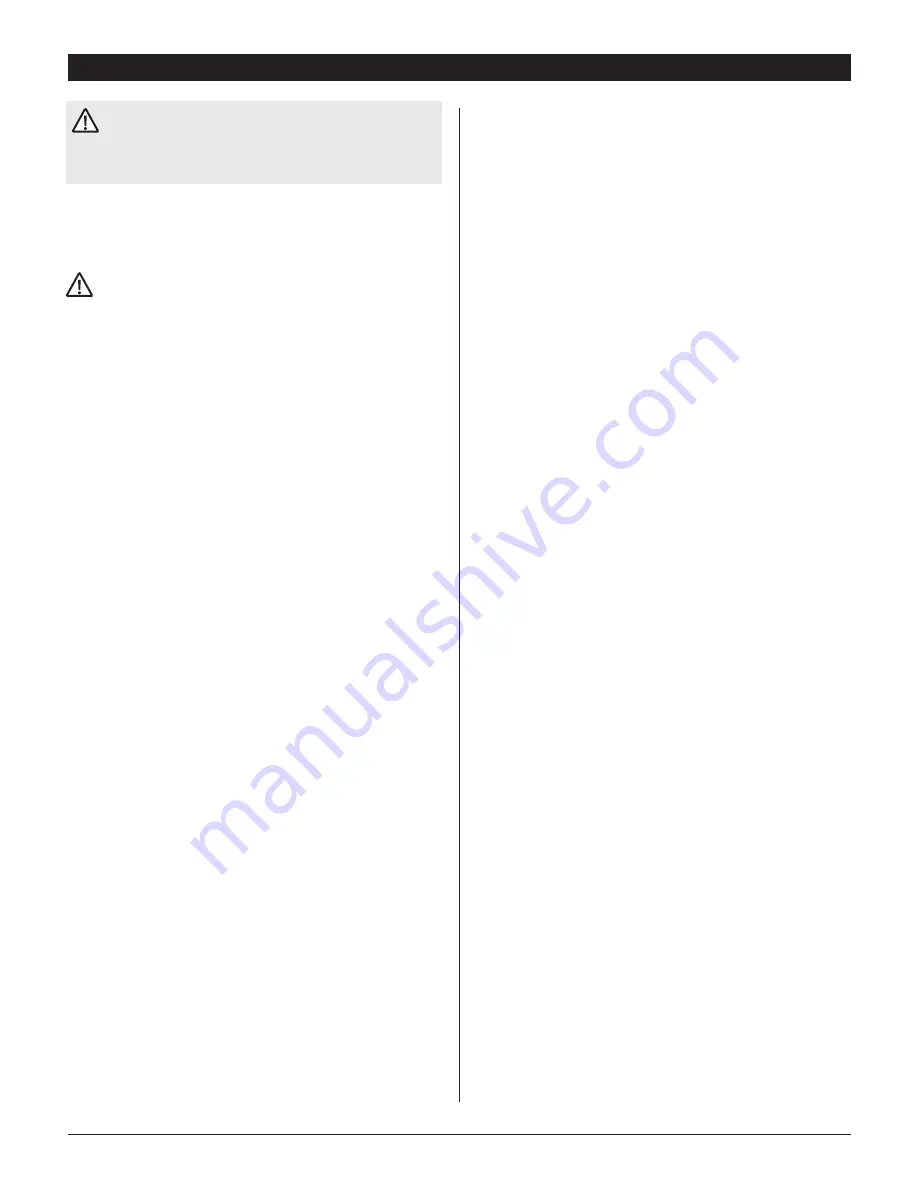
CAUTION!
— This symbol means
important instructions. failure to heed them can result
in injury or material property damage.
2. inSTallaTion
2.1 location
The SaniDry XP is designed to be installed indoors and is ideal for
unfinished and finished basements.
CAUTION!
• installation outdoors, or near a pool or spa will void
factory warranty.
• Do not use the dehumidifier as a bench or table.
2.1a in humid area, no ducting.
The simplest installation is to place the SaniDry XP in the humid
area with no ducting. The air inlet on top & outlet on the side
must be at least 1’ from walls and other obstructions to air
flow.
2.1B in humid area, duct inlet and/or outlet.
If the humid area is very large or has high ceilings,
dehumidification can be improved by adding an inlet and/or
outlet duct to circulate and destratify stagnant areas. For a
large area, add inlet or outlet ducting to create flow across the
area’s greatest length. For areas with ceilings higher than 12’,
use an inlet duct to draw warm, moist air from near the ceiling.
See section 2.4 for attaching duct collars & ducting.
2.1C in a Remote area, Duct inlet & outlet.
It is often desirable, in finished areas, to install the SaniDry
XP in an adjacent equipment room or unfinished area. Air is
transferred between the humid room and the unit via ducting.
The factory-mounted humidity control on the SaniDry XP
cabinet will sense the humidity in the humid room accurately
enough with this installation method.
2.1D in a Remote area, Duct outlet only.
A simpler remote installation method than above uses ducting
between the SaniDry XP discharge and the humid room; the
SaniDry XP inlet draws air from the room in which it’s located.
This works well if there is an adequate air flow path between the
two rooms; i.e. high door undercut, louvered door or wall grill.
There are several potential disadvantages to using this method.
First, humid air is drawn into the room where the SaniDry XP is
located. Second, to accurately sense humidity, the blower in the
SaniDry XP may need to run continuously to draw air from the
humid room into the SaniDry XP room. Third, a slight negative
pressure is created in the room with the SaniDry XP which could
backdraft open combustion devices located there. If such devices
are present, call the factory for specific instructions before using
this installation method or consider the option 2.1E below.
2.1e in a Remote area, Duct inlet only.
When the SaniDry XP is located in a room separate from the
main area to be dehumidified, it may be desirable to dehumidify
and/or slightly pressurize that room. Pressurization assures
that open combustion devices do not backdraft. This can be
accomplished by installing a duct from the humid room to the
SaniDry XP inlet and by allowing the SaniDry XP to discharge
dehumidified air into the room in which it’s located. An
adequate air flow path must exist between the two rooms for
this method to work well.
2.2 electrical Requirements
The SaniDry XP plugs into a common grounded outlet on a 15 Amp
circuit. It draws between 6 and 7 Amps under normal operating
conditions.
2.3 Condensate Removal
Condensate drains by gravity via the clear hose extending from
the unit. Route hose to a floor drain, sump pump, or drainage
system. Use care to keep the hose as flat to the floor as possible.
Excessive humps or kinks will prevent proper drainage.
If the SaniDry XP is located too far from a floor drain for the
attached hose to reach, 1/2" PVC pipe can be used to extend
it. It is commonly available in 10’ lengths from building supply,
plumbing and hardware stores. It will slide tightly inside the end of
the drain hose.
If more than one length of pipe is required, they can be joined with
a short piece cut from the end of the drain hose.
2.4 Ducting
2.4a optional Ducting
An inlet shroud with an 8" round collar and an 8" round
exhaust collar are available from the factory that will allow
round ducting to be attached to the inlet and/or outlet of the
SaniDry XP.
2.4B Ducting for Dehumidification
Ducting the SaniDry XP as mentioned in sections 2.1B-2.1E
requires consideration of the following points:
Duct Sizing:
For total duct lengths up to 25 feet, use a
minimum 8" diameter round or equivalent rectangular. For
longer lengths, use a minimum 10" diameter or equivalent.
Grills or diffusers on the duct ends must not excessively restrict
air flow.
isolated areas:
Effective dehumidification may require
that ducting be branched to isolated, stagnant areas. Use 6"
diameter branch ducting to each of two or three areas, use 4"
to each of four or more areas.
3. Dehumidifier operation
3.1 Humidity Control
The dehumidifier will run continuously until relative humidity
(RH) is reduced to the desired humidity level using the electronic
controller. Setting the electronic humidity controller to lower RH
levels will
noT
increase the unit’s dehumidification rate - it will
simply run longer to reduce the area’s RH to the setting. The
SaniDry XP unit (and refrigerant based dehumidifiers in general)
will reduce a warm space’s RH to a lower level than that of a cool
space. For example, the SaniDry XP may reduce an 80° F space to
30% RH. However, if the same space is 65° F, it may only reduce
it to 40% RH. It is therefore pointless to set the electronic humidity
SaniDry XP INSTALLER'S AND OWNER'S MANUAL
3
SaniDry XP Installer’s & Owner’s Manual
Summary of Contents for SD109 SaniDry XP
Page 1: ......





























